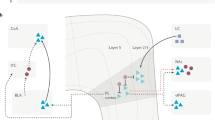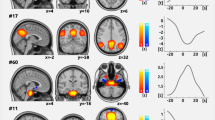Abstract
Searching for pain-preferential neural activity is essential for understanding and managing pain. Here, we investigated the preferential role of thalamocortical neural dynamics in encoding pain using human neuroimaging and rat electrophysiology across three studies. In study 1, we found that painful stimuli preferentially activated the medial-dorsal (MD) thalamic nucleus and its functional connectivity with the dorsal anterior cingulate cortex (dACC) and insula in two human functional magnetic resonance imaging (fMRI) datasets (n = 399 and n = 25). In study 2, human fMRI and electroencephalography fusion analyses (n = 220) revealed that pain-preferential MD responses were identified 89–295 ms after painful stimuli. In study 3, rat electrophysiology further showed that painful stimuli preferentially activated MD neurons and MD–ACC connectivity. These converging cross-species findings provided evidence for pain-preferential thalamocortical neural dynamics, which could guide future pain evaluation and management strategies.
This is a preview of subscription content, access via your institution
Access options
Access Nature and 54 other Nature Portfolio journals
Get Nature+, our best-value online-access subscription
$29.99 / 30 days
cancel any time
Subscribe to this journal
Receive 12 digital issues and online access to articles
$119.00 per year
only $9.92 per issue
Buy this article
- Purchase on Springer Link
- Instant access to full article PDF
Prices may be subject to local taxes which are calculated during checkout







Similar content being viewed by others
Data availability
Individual fMRI, EEG and rodent electrophysiological data are available at ScienceDB (https://doi.org/10.57760/sciencedb.psych.00120).
Code availability
MRI and EEG data analyses were based on standard procedures and codes in SPM and EEGLAB. The machine learning based analyses were based on the codes in LIBSVM. Customized codes for EEG-fMRI fusion can be requested from the corresponding authors.
References
Raja, S. N. et al. The revised International Association for the Study of Pain definition of pain: concepts, challenges and compromises. Pain 161, 1976–1982 (2020).
Wager, T. D. et al. An fMRI-based neurologic signature of physical pain. N. Engl. J. Med. 368, 1388–1397 (2013).
Tu, Y. et al. Alpha and gamma oscillation amplitudes synergistically predict the perception of forthcoming nociceptive stimuli. Hum. Brain Mapp. 37, 501–514 (2016).
Legrain, V., Iannetti, G., Plaghki, L. & Mouraux, A. The pain matrix reloaded: a salience detection system for the body. Prog. Neurobiol. 93, 111–124 (2011).
Liang, M., Su, Q., Mouraux, A. & Iannetti, G. D. Spatial patterns of brain activity preferentially reflecting transient pain and stimulus intensity. Cereb. Cortex 29, 2211–2227 (2019).
Ghazanfar, A. A. & Schroeder, C. E. Is neocortex essentially multisensory? Trends Cogn. Sci. 10, 278–285 (2006).
Liang, M., Mouraux, A., Hu, L. & Iannetti, G. D. Primary sensory cortices contain distinguishable spatial patterns of activity for each sense. Nat. Commun. 4, 1979 (2013).
Kayser, C. The multisensory nature of unisensory cortices: a puzzle continued. Neuron 67, 178–180 (2010).
Mouraux, A., Diukova, A., Lee, M. C., Wise, R. G. & Iannetti, G. D. A multisensory investigation of the functional significance of the ‘pain matrix’. Neuroimage 54, 2237–2249 (2011).
Su, Q. et al. Brain regions preferentially responding to transient and iso-intense painful or tactile stimuli. Neuroimage 192, 52–65 (2019).
Zhang, X. et al. A multisensory fMRI investigation of nociceptive-preferential cortical regions and responses. Front. Neurosci. 15, 420 (2021).
Tang, J. et al. Brain gene expression pattern correlated with the differential brain activation by pain and touch in humans. Cereb. Cortex 31, 3506–3521 (2021).
Auvray, M., Myin, E. & Spence, C. The sensory-discriminative and affective-motivational aspects of pain. Neurosci. Biobehav. Rev. 34, 214–223 (2010).
Coghill, R. C. The distributed nociceptive system: a framework for understanding pain. Trends Neurosci. 43, 780–794 (2020).
Kulkarni, B. et al. Attention to pain localization and unpleasantness discriminates the functions of the medial and lateral pain systems. Eur. J. Neurosci. 21, 3133–3142 (2005).
Najdenovska, E. et al. In-vivo probabilistic atlas of human thalamic nuclei based on diffusion-weighted magnetic resonance imaging. Sci. Data 5, 180270 (2018).
Horing, B., Sprenger, C. & Büchel, C. The parietal operculum preferentially encodes heat pain and not salience. PLoS Biol. 17, e3000205 (2019).
Cichy, R. M. & Oliva, A. A M/EEG-fMRI fusion primer: resolving human brain responses in space and time. Neuron 107, 772–781 (2020).
Mouraux, A. & Iannetti, G. D. The search for pain biomarkers in the human brain. Brain 141, 3290–3307 (2018).
Borsook, D., Edwards, R., Elman, I., Becerra, L. & Levine, J. Pain and analgesia: the value of salience circuits. Prog. Neurobiol. 104, 93–105 (2013).
Apkarian, A. V., Bushnell, M. C., Treede, R. D. & Zubieta, J. K. Human brain mechanisms of pain perception and regulation in health and disease. Eur. J. Pain 9, 463–484 (2005).
Iannetti, G. D., Hughes, N. P., Lee, M. C. & Mouraux, A. Determinants of laser-evoked EEG responses: pain perception or stimulus saliency? J. Neurophysiol. 100, 815–828 (2008).
Seminowicz, D. A. & Davis, K. D. Interactions of pain intensity and cognitive load: the brain stays on task. Cereb. Cortex 17, 1412–1422 (2007).
Wiech, K., Ploner, M. & Tracey, I. Neurocognitive aspects of pain perception. Trends Cogn. Sci. 12, 306–313 (2008).
Salomons, T. V., Iannetti, G. D., Liang, M. & Wood, J. N. The ‘pain matrix’ in pain-free individuals. JAMA Neurol. 73, 755–756 (2016).
Segerdahl, A. R., Mezue, M., Okell, T. W., Farrar, J. T. & Tracey, I. The dorsal posterior insula subserves a fundamental role in human pain. Nat. Neurosci. 18, 499–500 (2015).
Lieberman, M. D. & Eisenberger, N. I. The dorsal anterior cingulate cortex is selective for pain: results from large-scale reverse inference. Proc. Natl Acad. Sci. USA 112, 15250–15255 (2015).
Downar, J., Crawley, A. P., Mikulis, D. J. & Davis, K. D. A multimodal cortical network for the detection of changes in the sensory environment. Nat. Neurosci. 3, 277–283 (2000).
Heeger, D. J. & Ress, D. What does fMRI tell us about neuronal activity? Nat. Rev. Neurosci. 3, 142–151 (2002).
Tu, Y. et al. Distinct thalamocortical network dynamics are associated with the pathophysiology of chronic low back pain. Nat. Commun. 11, 3948 (2020).
Woolf, C. J. & Mannion, R. J. Neuropathic pain: aetiology, symptoms, mechanisms and management. Lancet 353, 1959–1964 (1999).
Colloca, L. et al. Neuropathic pain. Nat. Rev. Dis. Prim. 3, 17002 (2017).
Zhou, L. et al. A modality-specific dysfunction of pain processing in schizophrenia. Hum. Brain Mapp. 41, 1738–1753 (2020).
Grossman, N. et al. Noninvasive deep brain stimulation via temporally interfering electric fields. Cell 169, 1029–1041 (2017).
Todd, N., McDannold, N. & Borsook, D. Targeted manipulation of pain neural networks: the potential of focused ultrasound for treatment of chronic pain. Neurosci. Biobehav. Rev. 115, 238–250 (2020).
Paxinos, G. & Watson, C. The Rat Brain in Stereotaxic Coordinates 6th edn (Academic Press, 2006).
Yue, L., Iannetti, G. D. & Hu, L. The neural origin of nociceptive-induced gamma-band oscillations. J. Neurosci. 40, 3478–3490 (2020).
Ashburner, J. & Friston, K. Unified segmentation. Neuroimage 26, 839–851 (2005).
Ciric, R. et al. Benchmarking of participant-level confound regression strategies for the control of motion artifact in studies of functional connectivity. Neuroimage 154, 174–187 (2017).
Delorme, A. & Makeig, S. EEGLAB: an open source toolbox for analysis of single-trial EEG dynamics including independent component analysis. J. Neurosci. Methods 134, 9–21 (2004).
Hazan, L., Zugaro, M. & Buzsáki, G. Klusters, NeuroScope, NDManager: a free software suite for neurophysiological data processing and visualization. J. Neurosci. Methods 155, 207–216 (2006).
Rossant, C. et al. Spike sorting for large, dense electrode arrays. Nat. Neurosci. 19, 634–641 (2016).
Chang, C. & Lin, C. LIBSVM: a library for support vector machines. ACM Trans. Intell. Syst. Technol. 2, 27 (2011).
Zhou, F. et al. A distributed fMRI-based signature for the subjective experience of fear. Nat. Commun. 12, 6643 (2021).
Haufe, S. et al. On the interpretation of weight vectors of linear models in multivariate neuroimaging. Neuroimage 87, 96–110 (2014).
Friston, K. J. et al. Psychophysiological and modulatory interactions in neuroimaging. Neuroimage 6, 218–229 (1997).
Di, X. & Biswal, B. Toward task connectomics: examining whole-brain task modulated connectivity in different task domains. Cereb. Cortex 29, 1572–1583 (2019).
Benedek, M. & Kaernbach, C. A continuous measure of phasic electrodermal activity. J. Neurosci. Methods 190, 80–91 (2010).
Hu, L. et al. Was it a pain or a sound? Across-species variability in sensory sensitivity. Pain 156, 2449–2457 (2015).
Yue, L., Zhang, F., Lu, X., Wan, Y. & Hu, L. Simultaneous recordings of cortical local field potentials and electrocorticograms in response to nociceptive laser stimuli from freely moving rats. J. Vis. Exp. 2019, e58686 (2019).
Buzsáki, G. Large-scale recording of neuronal ensembles. Nat. Neurosci. 7, 446–451 (2004).
Bokil, H. andrews, P., Kulkarni, J. E., Mehta, S. & Mitra, P. P. Chronux: a platform for analyzing neural signals. J. Neurosci. Methods 192, 146–151 (2010).
Maris, E. & Oostenveld, R. Nonparametric statistical testing of EEG- and MEG-data. J. Neurosci. Methods 164, 177–190 (2007).
Tu, Y. et al. How expectations of pain elicited by consciously and unconsciously perceived cues unfold over time. Neuroimage 235, 117985 (2021).
Cichy, R. M., Pantazis, D. & Oliva, A. Resolving human object recognition in space and time. Nat. Neurosci. 17, 455–462 (2014).
Acknowledgements
Y.T. is supported by STI2030-Major Projects by the Ministry of Science and Technology of China (grant no. 2022ZD0206400), National Natural Science Foundation of China (grant nos. 32171078 and 32322035), Scientific Foundation of the Institute of Psychology, Chinese Academy of Sciences (grant nos. E0CX52 and E2CX4015) and Young Elite Scientist Sponsorship Program by the China Association for Science and Technology (grant no. E1KX0210). L.H. is supported by National Natural Science Foundation of China (grant no. 32071061) and Beijing Natural Science Foundation (grant no. JQ22018). The funders had no role in study design, data collection and analysis, decision to publish or preparation of the manuscript.
Author information
Authors and Affiliations
Contributions
This work was conceptualized by Y.T. and L.H. who also developed the methodology, undertook project administration and supervision and acquired funding. Investigation was undertaken by Y.T., H.Z., Z.L., Y.B., L.Y. and L.H. Visualization was by Y.T. and Z.L. The original draft was written by Y.T., with review and editing by Y.T., L.Z. and L.H.
Corresponding authors
Ethics declarations
Competing interests
The authors declare no competing interests.
Peer review
Peer review information
Nature Human Behaviour thanks Ulrike Bingel, Giulia Liberati and Yuan B. Peng for their contribution to the peer review of this work. Peer reviewer reports are available. Peer reviewer reports are available.
Additional information
Publisher’s note Springer Nature remains neutral with regard to jurisdictional claims in published maps and institutional affiliations.
Supplementary information
Rights and permissions
Springer Nature or its licensor (e.g. a society or other partner) holds exclusive rights to this article under a publishing agreement with the author(s) or other rightsholder(s); author self-archiving of the accepted manuscript version of this article is solely governed by the terms of such publishing agreement and applicable law.
About this article
Cite this article
Tu, Y., Li, Z., Zhang, L. et al. Pain-preferential thalamocortical neural dynamics across species. Nat Hum Behav 8, 149–163 (2024). https://doi.org/10.1038/s41562-023-01714-6
Received:
Accepted:
Published:
Issue Date:
DOI: https://doi.org/10.1038/s41562-023-01714-6



